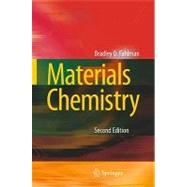
What is included with this book?
| Preface | p. ix |
| What is Materials Chemistry? | p. 1 |
| Historical Perspectives | p. 2 |
| Considerations in the Design of New Materials | p. 5 |
| Design of New Materials Through a ôCritical Thinkingö Approach | p. 6 |
| Solid-State Chemistry | p. 13 |
| Amorphous vs. Crystalline Solids | p. 13 |
| Types of Bonding in Solids | p. 14 |
| Ionic Solids | p. 15 |
| Metallic Solids | p. 16 |
| Covalent Network Solids | p. 18 |
| Molecular Solids | p. 18 |
| The Crystalline State | p. 22 |
| Crystal Growth Techniques | p. 26 |
| Crystal Structures | p. 29 |
| Crystal Symmetry and Space Groups | p. 56 |
| X-Ray Diffraction from Crystalline Solids | p. 65 |
| Crystal Imperfections | p. 74 |
| Physical Properties of Crystals | p. 88 |
| Bonding in Crystalline Solids: Introduction to Band Theory | p. 103 |
| The Amorphous State | p. 113 |
| Sol-Gel Processing | p. 114 |
| Glasses | p. 125 |
| Cementitious Materials | p. 136 |
| Ceramics | p. 139 |
| Metals | p. 157 |
| Mining and Processing of Metals | p. 157 |
| Powder Metallurgy | p. 171 |
| Metallic Structures and Properties | p. 177 |
| Phase Behavior of Iron-Carbon Alloys | p. 178 |
| Hardening Mechanisms of Steels | p. 185 |
| Stainless Steels | p. 200 |
| Nonferrous Metals and Alloys | p. 204 |
| Metal Surface Treatments for Corrosion Resistance | p. 217 |
| Magnetism | p. 220 |
| Reversible Hydrogen Storage | p. 226 |
| Semiconductors | p. 239 |
| Properties and Types of Semiconductors | p. 239 |
| Silicon-Based Applications | p. 251 |
| Silicon Wafer Production | p. 251 |
| Integrated Circuits | p. 255 |
| Light-Emitting Diodes: There is Life Outside of Silicon! | p. 321 |
| Thermoelectric (Te) Materials | p. 330 |
| Polymeric Materials | p. 349 |
| Polymer Classifications and Nomenclature | p. 351 |
| Polymerization Mechanisms | p. 356 |
| Addition Polymerization | p. 359 |
| Heterogeneous Catalysis | p. 364 |
| Homogeneous Catalysis | p. 366 |
| Step-Growth Polymerization | p. 372 |
| Dendritic Polymers | p. 376 |
| Polymerization via ôClickö Chemistry | p. 386 |
| ôSoft Materialsö Applications: Structure vs. Properties | p. 388 |
| Biomaterials Applications | p. 393 |
| Conductive Polymers | p. 417 |
| Molecular Magnets | p. 426 |
| Polymer Additives | p. 437 |
| Flame Retardants | p. 440 |
| Nanomaterials | p. 457 |
| Nanotoxicity | p. 458 |
| What is ôNanotechnologyö? | p. 468 |
| Nanoscale Building Blocks and Applications | p. 470 |
| Zero-Dimensional Nanomaterials | p. 473 |
| One-Dimensional Nanostructures | p. 529 |
| Two-Dimensional Nanostructures: The ôGraphene Frontierö | p. 559 |
| Materials Characterization | p. 585 |
| Optical Microscopy | p. 586 |
| Electron Microscopy | p. 588 |
| Electron Sources | p. 593 |
| Transmission Electron Microscopy (TEM) | p. 597 |
| Scanning Electron Microscopy (SEM) | p. 617 |
| Surface Characterization Techniques Based on Particle Bombardment | p. 629 |
| Photoelectron Spectroscopy (PES) | p. 629 |
| X-ray Absorption Fine Structure (XAFS) | p. 631 |
| Ion-Bombardment Techniques | p. 634 |
| Atom-Probe Tomography (APT) | p. 643 |
| Scanning Probe Microscopy (SPM) | p. 645 |
| Bulk Characterization Techniques | p. 651 |
| p. 669 | |
| p. 681 | |
| p. 693 | |
| Chemical Vapor Deposition of Carbon Nanotubes | p. 693 |
| Background Information | p. 693 |
| Procedure | p. 695 |
| Supercritical Fluid Facilitated Growth of Copper and Aluminum Oxide NanopArticles | p. 697 |
| Procedure | p. 698 |
| Synthesis and Characterization of Liquid Crystals | p. 700 |
| Procedure | p. 703 |
| Template Synthesis and Magnetic Manipulation of Nickel Nanowires | p. 705 |
| Procedure | p. 705 |
| Introduction to Photolithography | p. 709 |
| Procedure | p. 709 |
| Synthesis of Gold Nanoclusters | p. 712 |
| Procedure | p. 712 |
| Synthesis of Porous Silicon | p. 713 |
| Procedure | p. 714 |
| Solid-Liquid-Solid (SLS) Growth of Silicon Nanowires | p. 714 |
| Procedure | p. 716 |
| Synthesis of Ferrofluids | p. 717 |
| Metallurgy/Phase Transformations | p. 717 |
| Heat Treatment of Glass Ceramics | p. 717 |
| Index | p. 719 |
| Table of Contents provided by Ingram. All Rights Reserved. |
The New copy of this book will include any supplemental materials advertised. Please check the title of the book to determine if it should include any access cards, study guides, lab manuals, CDs, etc.
The Used, Rental and eBook copies of this book are not guaranteed to include any supplemental materials. Typically, only the book itself is included. This is true even if the title states it includes any access cards, study guides, lab manuals, CDs, etc.